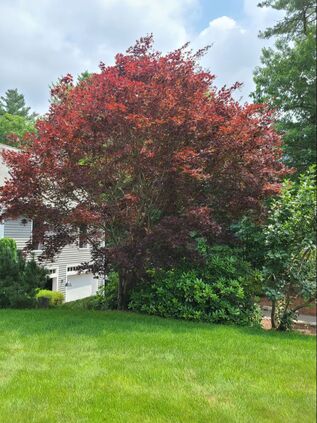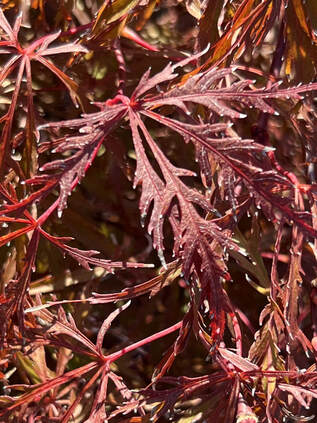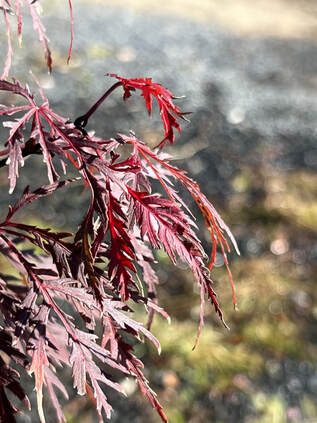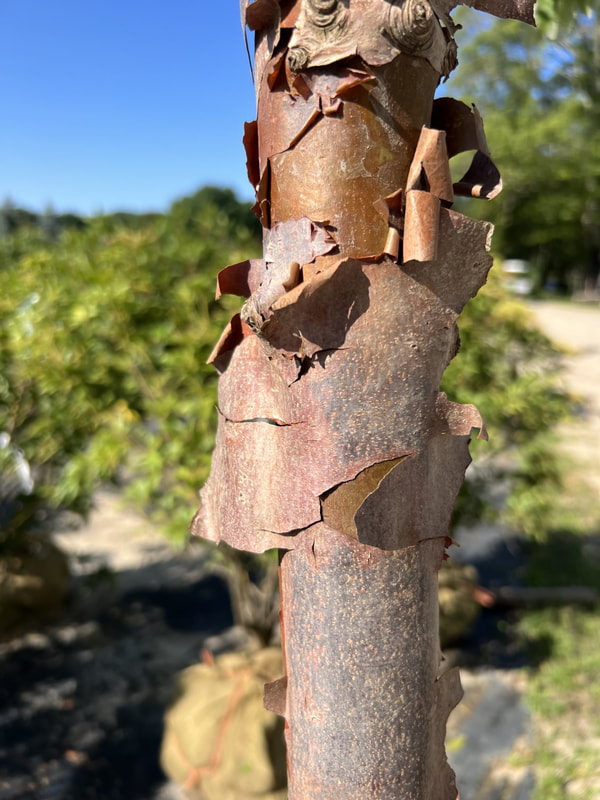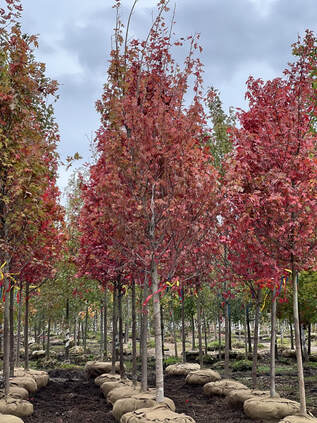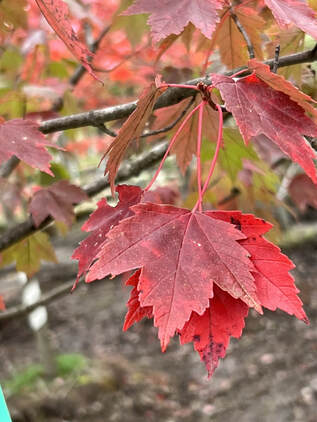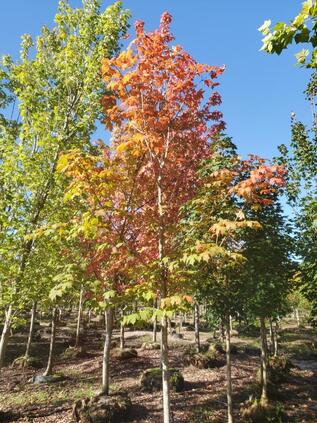Japanese Maple
Acer palmatum, is a deciduous shrub or small tree that typically grows to 10-25' tall. It is native to Japan, Korea and China. General plant form is rounded to broad-rounded, often with low branching. Each palmate green leaf has 5 or 7 but less frequently 9 pointed toothed lobes. Fall color includes shades of yellow, red-purple and bronze. Cultivars (often grafted) are quite variable.
Acer palmatum, is a deciduous shrub or small tree that typically grows to 10-25' tall. It is native to Japan, Korea and China. General plant form is rounded to broad-rounded, often with low branching. Each palmate green leaf has 5 or 7 but less frequently 9 pointed toothed lobes. Fall color includes shades of yellow, red-purple and bronze. Cultivars (often grafted) are quite variable.
Upright Japanese Maple
Maple Japanese Autumn Moon Yellow to burnt orange, with underlying tones ranging from orange, salmon and chartreuse. Fall foliage is varying shades of gold to red.
Maple Japanese Bloodgood deep reddish-purple summer foliage, good crimson-red fall color.
Maple Japanese Coral Bark showy pink bark; yellow gold fall color
Maple Japanese Emperor dark purple red foliage in spring/summer turns scarlet red in fall
Maple Japanese Fireglow deep red foliage persisting through summer, purple-scarlet to crimson red fall colors
Maple Japanese Orangeola green to purple and then a brilliant shade of orange-red in the fall
Weeping Japanese Maple
Var. dissectum is typically a much smaller, rounded, slow-growing shrubby form (often with cascading branching) that rarely matures to more than 12' tall with a larger spread. Palmate leaves, each having 7-11 deeply incised lobes, are deeply cut to the base of the leaf. These dissected-leaf shrubs are commonly called laceleaf Japanese maple, cutleaf Japanese maple or threadleaf Japanese maple. Dissectum means deeply cut in reference to the deeply cut, feathery nature of the leaves.
Var. dissectum is typically a much smaller, rounded, slow-growing shrubby form (often with cascading branching) that rarely matures to more than 12' tall with a larger spread. Palmate leaves, each having 7-11 deeply incised lobes, are deeply cut to the base of the leaf. These dissected-leaf shrubs are commonly called laceleaf Japanese maple, cutleaf Japanese maple or threadleaf Japanese maple. Dissectum means deeply cut in reference to the deeply cut, feathery nature of the leaves.
Maple Japanese Crimson Queen crimson color throughout summer, can turn bright scarlet in autumn
Maple Japanese Inaba Shidare outstanding reddish-purple color holds well all season. Fall color tends to be a brighter red than other selections
Maple Japanese Red Dragon beautiful purple leaves, bright, apple red fall color.
Maple Japanese Tamukeyama beautiful purple-red foliage, bright red in the fall
Maple Japanese Viridis vivid green leaves, beautiful shades of gold and crimson in the fall.
Paperbark Maple soft green leaves turn scarlet in fall
A small, deciduous, oval to oval-rounded tree with slender upright branching. It is particularly noted for its exfoliating copper orange to cinnamon reddish/brown bark and its showy orange to red fall color. It typically matures to 20-30 (40)’ tall. Bark on the trunk and limbs is extremely ornamental because it peels into large curls which remain on the tree rather that falling to the ground, often in attractive contrast to the tan to rose-brown inner bark. Leaves are green above, but frosty blue-green to gray-green with fine hairs beneath. Fall color varies, typically ranging from showy shades of orange and red to less spectacular shades of reddish-green to bronze green.
A small, deciduous, oval to oval-rounded tree with slender upright branching. It is particularly noted for its exfoliating copper orange to cinnamon reddish/brown bark and its showy orange to red fall color. It typically matures to 20-30 (40)’ tall. Bark on the trunk and limbs is extremely ornamental because it peels into large curls which remain on the tree rather that falling to the ground, often in attractive contrast to the tan to rose-brown inner bark. Leaves are green above, but frosty blue-green to gray-green with fine hairs beneath. Fall color varies, typically ranging from showy shades of orange and red to less spectacular shades of reddish-green to bronze green.
Red Maple
A medium-sized, deciduous tree. It typically grows 40-60’ tall with a rounded to oval crown. Emerging new growth leaves, leafstalks, twigs, flowers, fruit and fall color are red or tinged with red. Quality of red fall color on species plants is variable. Leaves are medium to dark green above and gray green below. Flowers on a given tree are primarily male or female or monoecious and appear in late winter to early spring (March-April) before the leaves. Fruit is a two-winged samara.
A medium-sized, deciduous tree. It typically grows 40-60’ tall with a rounded to oval crown. Emerging new growth leaves, leafstalks, twigs, flowers, fruit and fall color are red or tinged with red. Quality of red fall color on species plants is variable. Leaves are medium to dark green above and gray green below. Flowers on a given tree are primarily male or female or monoecious and appear in late winter to early spring (March-April) before the leaves. Fruit is a two-winged samara.
Maple Autumn Blaze
Maple Red Autumn Spire handsome green foliage most amazing scarlet in fall
Maple Red Brandywine
Maple Red October Glory medium green leaves, bright orange to deep, reddish purple fall color
Maple Red Sunset glossy green leaves, turn a brilliant orange-scarlet in fall
Maple Red Redpointe Dark green, foliage turns a brilliant red in early autumn
Maple Red Sun Valley glossy green leaves, turn orange-red to brilliant red in the fall.
Sugar Maple
A deciduous tree which will typically grow 40' to 80' tall with a dense, rounded crown. This tree is a main component of the Eastern U.S. hardwood forest and is one of the trees which is most responsible for giving New England its reputation for spectacular fall color. Medium green leaves turn yellow-orange in autumn, sometimes with considerable color variations. Sugar maples are long-lived trees which grow relatively slowly. Excellent shade tree.
A deciduous tree which will typically grow 40' to 80' tall with a dense, rounded crown. This tree is a main component of the Eastern U.S. hardwood forest and is one of the trees which is most responsible for giving New England its reputation for spectacular fall color. Medium green leaves turn yellow-orange in autumn, sometimes with considerable color variations. Sugar maples are long-lived trees which grow relatively slowly. Excellent shade tree.
Maple Sugar Fall Fiesta
Maple Sugar Green Mountain thick deep green foliage, excellent shades of orange and scarlet in fall.
Maple Sugar Legacy
Tartarian Maple
Acer tataricum, commonly called Tatarian maple, typically grows as a small, upright spreading tree with a dense, rounded crown or as a large multi-stemmed shrub. It matures over time to 15-20’ tall. Leaves turn yellow and red in fall. Greenish-white flowers in erect, long-peduncled panicles bloom in spring. Flowers are followed by winged samaras that turn a showy red in summer/fall as they mature.
Acer tataricum, commonly called Tatarian maple, typically grows as a small, upright spreading tree with a dense, rounded crown or as a large multi-stemmed shrub. It matures over time to 15-20’ tall. Leaves turn yellow and red in fall. Greenish-white flowers in erect, long-peduncled panicles bloom in spring. Flowers are followed by winged samaras that turn a showy red in summer/fall as they mature.
Maple Amur turns a brilliant, fiery red in autumn.
Maple x. Freemanii Armstrong
Maple Silver Armstrong

